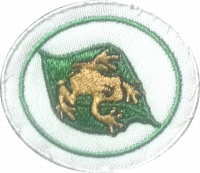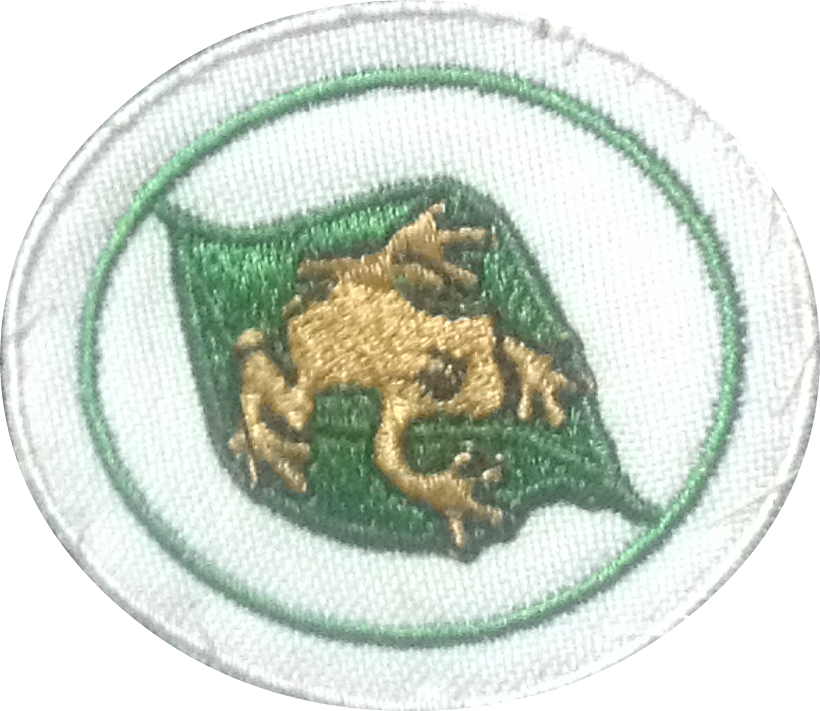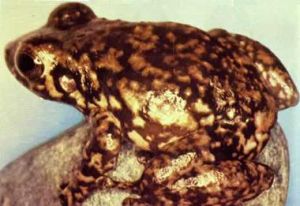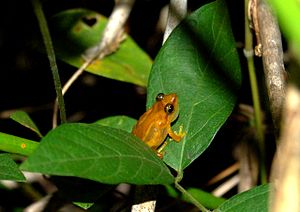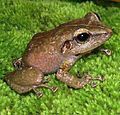Difference between revisions of "AY Honors/Coquí/Answer Key/es"
(Created page with "</noinclude> <!-- 4. Decir las características generales de esta clase. --> Son de sangre fría; la piel carece de cubierta alguna, son suaves y húmedas, a excepción de la...") |
(Updating to match new version of source page) |
||
| (33 intermediate revisions by 2 users not shown) | |||
| Line 1: | Line 1: | ||
| − | + | {{HonorSubpage}} | |
| − | + | <section begin="Body" /> | |
| − | |||
| − | {{ | ||
| − | |||
| − | |||
| − | |||
| − | |||
| − | |||
| − | |||
| − | }} | ||
| − | |||
| − | |||
| − | |||
| − | <section begin="Body" /> | ||
{{ansreq|page={{#titleparts:{{PAGENAME}}|2|1}}|num=1}} | {{ansreq|page={{#titleparts:{{PAGENAME}}|2|1}}|num=1}} | ||
<noinclude></noinclude> | <noinclude></noinclude> | ||
| Line 31: | Line 18: | ||
<noinclude></noinclude> | <noinclude></noinclude> | ||
<!-- 3. ¿Qué miembro de esta clase se menciona en la Biblia? --> | <!-- 3. ¿Qué miembro de esta clase se menciona en la Biblia? --> | ||
| − | Las ranas se mencionan en la Biblia, más famosa como una de las 10 plagas contra los egipcios, que se encuentran en [https://www.biblegateway.com/passage/?search=exodus+8%3A2-13&version=RVR1995 Éxodo capítulo 8]. También se mencionan en [https://www.biblegateway.com/passage/?search=Psalms+105%3A30&version=RVR1995 | + | Las ranas se mencionan en la Biblia, más famosa como una de las 10 plagas contra los egipcios, que se encuentran en [https://www.biblegateway.com/passage/?search=exodus+8%3A2-13&version=RVR1995 Éxodo capítulo 8]. También se mencionan en [https://www.biblegateway.com/passage/?search=psalms+78%3A45&version=RVR1995 Salmos 78:45], [https://www.biblegateway.com/passage/?search=Psalms+105%3A30&version=RVR1995 105:30] y [https://www.biblegateway.com/passage/?search=apocalipsis+16%3A13&version=RVR1995 Apocalipsis 16:13]. |
<noinclude></noinclude> | <noinclude></noinclude> | ||
| Line 44: | Line 31: | ||
{{ansreq|page={{#titleparts:{{PAGENAME}}|2|1}}|num=5}} | {{ansreq|page={{#titleparts:{{PAGENAME}}|2|1}}|num=5}} | ||
<noinclude></noinclude> | <noinclude></noinclude> | ||
| − | <!-- 5. | + | <!-- 5. ¿Qué características distinguen a los coquíes del resto de los anfibios? --> |
| − | + | Una ausencia de una membrana interdigital (lo que significa que no están adaptados para nadar); el falange terminal está en forma de T; tiene reproducción terrestre y desarrollo directo, lo que significa que no tienen una etapa de renacuajo, nacen de huevos como ranas pequeñas completamente formadas. | |
<noinclude></noinclude> | <noinclude></noinclude> | ||
| Line 51: | Line 38: | ||
{{ansreq|page={{#titleparts:{{PAGENAME}}|2|1}}|num=6}} | {{ansreq|page={{#titleparts:{{PAGENAME}}|2|1}}|num=6}} | ||
<noinclude></noinclude> | <noinclude></noinclude> | ||
| − | <!-- 6. | + | <!-- 6. ¿Por qué se les llama coquí? --> |
| − | + | Se les llama coquí por el canto, sonido o llamado que emiten los machos durante la noche. | |
<noinclude></noinclude> | <noinclude></noinclude> | ||
| Line 58: | Line 45: | ||
{{ansreq|page={{#titleparts:{{PAGENAME}}|2|1}}|num=7}} | {{ansreq|page={{#titleparts:{{PAGENAME}}|2|1}}|num=7}} | ||
<noinclude></noinclude> | <noinclude></noinclude> | ||
| − | <!-- 7. | + | <!-- 7. ¿Qué otro sonido, canto o llamada, además de «coquí», emiten los coquíes? --> |
| − | + | Diferentes coquíes hacen diferentes tipos de sonidos, tales como: | |
| − | + | «Churi- ki – ki – ki», [[esw:Eleutherodactylus_antillensis|Coquí churí]] (''Eleutherodactylus antillensis'')<br /><br /> | |
{{#widget:YouTube|id=-Kg6F8E0B24}} | {{#widget:YouTube|id=-Kg6F8E0B24}} | ||
| − | + | «Tic – tic – tic», [[esw:Eleutherodactylus_brittoni|Coquí de las hierbas]] (''Eleutherodactylus brittoni'')<br /><br /> | |
{{#widget:YouTube|id=O_7RndpknfY}} | {{#widget:YouTube|id=O_7RndpknfY}} | ||
| − | + | «Clicks – clicks», [[esw:Eleutherodactylus_eneidae|Coquí de Eneida]] (''Eleutherodactylus eneidae'')<br /><br /> | |
{{#widget:YouTube|id=cIxQMx9ykec}} | {{#widget:YouTube|id=cIxQMx9ykec}} | ||
| − | + | Pito fino y prolongado, [[esw:Eleutherodactylus_cochranae|Coquí pitito]] (''Eleutherodactylus cochranae'')<br /><br /> | |
{{#widget:YouTube|id=3qWbIBrLOC0}} | {{#widget:YouTube|id=3qWbIBrLOC0}} | ||
| − | + | «Chip – chip» buy bajo, [[esw:Eleutherodactylus_richmondi|Coquí caoba]], (''Eleutherodactylus richmondi'')<br /><br /> | |
{{#widget:YouTube|id=RvYUfI01tj4}} | {{#widget:YouTube|id=RvYUfI01tj4}} | ||
| − | + | Como gotas de agua al caer, [[esw:Eleutherodactylus_monensis|Coquí de Mona]] (''Eleutherodactylus monensis'')<br /><br /> | |
{{#widget:YouTube|id=L8cfyPym9sc}} | {{#widget:YouTube|id=L8cfyPym9sc}} | ||
| − | + | «Tuit – tuit – tuit», [[esw:Eleutherodactylus_jasperi|Coquí dorado]] (''Eleutherodactylus jasperi'')<br /><br /> | |
{{#widget:YouTube|id=hLo8rqnb2ME}} | {{#widget:YouTube|id=hLo8rqnb2ME}} | ||
| Line 85: | Line 72: | ||
{{ansreq|page={{#titleparts:{{PAGENAME}}|2|1}}|num=8}} | {{ansreq|page={{#titleparts:{{PAGENAME}}|2|1}}|num=8}} | ||
<noinclude></noinclude> | <noinclude></noinclude> | ||
| − | <!-- 8. | + | <!-- 8. ¿Cuál es la función del canto del coquí? --> |
| − | + | Este sonido tiene dos propósitos; el «CO» sirve para repeler a los machos y establecer un territorio, mientras que el «QUI» sirve para atraer a las hembras. | |
<noinclude></noinclude> | <noinclude></noinclude> | ||
| Line 92: | Line 79: | ||
{{ansreq|page={{#titleparts:{{PAGENAME}}|2|1}}|num=9}} | {{ansreq|page={{#titleparts:{{PAGENAME}}|2|1}}|num=9}} | ||
<noinclude></noinclude> | <noinclude></noinclude> | ||
| − | <!-- | + | <!-- ¿Cuál es el género de la especie del coquí puertorriqueño? Dar el nombre de 5 de las especies y mostrar láminas o fotografías de las mismas. --> |
| − | + | El género se llama [[esw:Eleutherodactylus|Eleutherodactylus]]; hay varias, varias especies que pertenecen a este género. Aquí hay algunos ejemplos: | |
<gallery> | <gallery> | ||
| − | File:Eleutherodactylus dimidiatus01.jpg|[[ | + | File:Eleutherodactylus dimidiatus01.jpg|[[esw:Eleutherodactylus_dimidiatus|''Eleutherodactylus dimidiatus'']] |
| − | File:Eleutherodactylus antillensis01.jpg|[[ | + | File:Eleutherodactylus antillensis01.jpg|[[esw:Eleutherodactylus_antillensis|Coquí churí]] (''Eleutherodactylus antillensis'') |
| − | File:Coqui frog.jpg|[[ | + | File:Coqui frog.jpg|[[esw:Eleutherodactylus_unicolor|Coquí duende]] (''Eleutherodactylus unicolor'') |
| − | File:Eleutherodactylus guttilatus.jpg| | + | File:Eleutherodactylus guttilatus.jpg|''Eleutherodactylus guttilatus'' |
| − | File:Craugastor punctariolus01.jpg|[[ | + | File:Craugastor punctariolus01.jpg|[[esw:Craugastor_punctariolus|''Craugastor punctariolus'']] |
| − | File:Craugastor pozo.jpeg|[[ | + | File:Craugastor pozo.jpeg|[[esw:Craugastor_pozo|''Craugastor pozo'']] |
| − | File:Eleutherodactylus ionthus.jpg|[[ | + | File:Eleutherodactylus ionthus.jpg|[[esw:Eleutherodactylus_ionthus|''Eleutherodactylus ionthus'']] |
| − | File:Lesser Antillean whistling frog (Eleutherodactylus johnstonei).JPG|[[ | + | File:Lesser Antillean whistling frog (Eleutherodactylus johnstonei).JPG|[[esw:Coqu%C3%AD_antillano|Coquí antillano]] (''Eleutherodactylus johnstonei'') |
</gallery> | </gallery> | ||
| Line 110: | Line 97: | ||
{{ansreq|page={{#titleparts:{{PAGENAME}}|2|1}}|num=10}} | {{ansreq|page={{#titleparts:{{PAGENAME}}|2|1}}|num=10}} | ||
<noinclude></noinclude> | <noinclude></noinclude> | ||
| − | <!-- 10. | + | <!-- 10. ¿En cuáles otros países, fuera de Puerto Rico, se encuentran los coquíes? --> |
| − | Colombia, Cuba, Guatemala, | + | [[esw:Colombia|Colombia]], [[esw:Cuba|Cuba]], [[esw:Guatemala|Guatemala]], [[esw:República_Dominicana|República Dominicana]], [[esw:Islas_Vírgenes_de_los_Estados_Unidos|Islas Vírgenes de EE. UU.]], [[esw:Islas_Vírgenes_Británicas|Islas Vírgenes del Reino Unido]] |
<noinclude></noinclude> | <noinclude></noinclude> | ||
| Line 117: | Line 104: | ||
{{ansreq|page={{#titleparts:{{PAGENAME}}|2|1}}|num=11}} | {{ansreq|page={{#titleparts:{{PAGENAME}}|2|1}}|num=11}} | ||
<noinclude></noinclude> | <noinclude></noinclude> | ||
| − | <!-- 11. | + | <!-- 11. ¿Cuál es el coquí: --> |
<noinclude></noinclude> | <noinclude></noinclude> | ||
{{ansreq|page={{#titleparts:{{PAGENAME}}|2|1}}|num=11a}} <!--T:13--> | {{ansreq|page={{#titleparts:{{PAGENAME}}|2|1}}|num=11a}} <!--T:13--> | ||
<noinclude></noinclude> | <noinclude></noinclude> | ||
| − | + | El [[esw:Eleutherodactylus_karlschmidti|coquí palmeado]] (''Eleutherodactylus karlschmidti'').<br /> | |
| − | [[File:5 Web-footed Coquí.jpg|thumb|left| | + | [[File:5 Web-footed Coquí.jpg|thumb|left|Coquí palmeado]] |
{{clear}} | {{clear}} | ||
| Line 130: | Line 117: | ||
{{ansreq|page={{#titleparts:{{PAGENAME}}|2|1}}|num=11b}} <!--T:14--> | {{ansreq|page={{#titleparts:{{PAGENAME}}|2|1}}|num=11b}} <!--T:14--> | ||
<noinclude></noinclude> | <noinclude></noinclude> | ||
| − | + | El [[esw:Eleutherodactylus_juanariveroi|coquí llanero]] (''Eleutherodactylus juanariveroi'') | |
| − | [[File:CoquiLlanero.jpg|thumb|left| | + | [[File:CoquiLlanero.jpg|thumb|left|Coquí llanero]] |
{{clear}} | {{clear}} | ||
| Line 139: | Line 126: | ||
<noinclude></noinclude> | <noinclude></noinclude> | ||
<gallery> | <gallery> | ||
| − | File:Common Coquí.jpg|[[ | + | File:Common Coquí.jpg|[[esw:Eleutherodactylus_coqui|Coquí común]] (''Eleutherodactylus coqui'') |
| − | File:Female guajon frog on tree.jpg|[[ | + | File:Female guajon frog on tree.jpg|[[esw:Eleutherodactylus_cooki|Coquí guajón]] (''Eleutherodactylus cooki'') |
| − | File:Upland coquí.jpg|[[ | + | File:Upland coquí.jpg|[[esw:Eleutherodactylus_portoricensis|Coquí de la montaña]] (''Eleutherodactylus portoricensis'') |
| − | File:Melodious coquí.jpg|[[ | + | File:Melodious coquí.jpg|[[esw:Eleutherodactylus_wightmanae|Coquí melodioso]] (''Eleutherodactylus wightmanae'') |
</gallery> | </gallery> | ||
| Line 149: | Line 136: | ||
{{ansreq|page={{#titleparts:{{PAGENAME}}|2|1}}|num=11d}} <!--T:16--> | {{ansreq|page={{#titleparts:{{PAGENAME}}|2|1}}|num=11d}} <!--T:16--> | ||
<noinclude></noinclude> | <noinclude></noinclude> | ||
| − | + | El [[esw:Eleutherodactylus_monensis|coquí de Mona]] (''Eleutherodactylus monensis'')<br /><br /> | |
{{#widget:YouTube|id=L8cfyPym9sc}} | {{#widget:YouTube|id=L8cfyPym9sc}} | ||
| Line 156: | Line 143: | ||
{{ansreq|page={{#titleparts:{{PAGENAME}}|2|1}}|num=11e}} <!--T:17--> | {{ansreq|page={{#titleparts:{{PAGENAME}}|2|1}}|num=11e}} <!--T:17--> | ||
<noinclude></noinclude> | <noinclude></noinclude> | ||
| − | + | El [[esw:Eleutherodactylus_unicolor|coquí duende]]. | |
| − | <br /><br />( | + | <br /><br />(a 0:14 segundos)<br />{{#widget:YouTube|id=zdQzRewxyvI}} |
<noinclude></noinclude> | <noinclude></noinclude> | ||
| Line 163: | Line 150: | ||
{{ansreq|page={{#titleparts:{{PAGENAME}}|2|1}}|num=11f}} <!--T:18--> | {{ansreq|page={{#titleparts:{{PAGENAME}}|2|1}}|num=11f}} <!--T:18--> | ||
<noinclude></noinclude> | <noinclude></noinclude> | ||
| − | + | El [[esw:Eleutherodactylus_karlschmidti|coquí palmeado]] (''Eleutherodactylus karlschmidti'').<br /> | |
| − | [[File:5 Web-footed Coquí.jpg|thumb|left| | + | [[File:5 Web-footed Coquí.jpg|thumb|left|Coquí palmeado]] |
{{clear}} | {{clear}} | ||
| Line 171: | Line 158: | ||
{{ansreq|page={{#titleparts:{{PAGENAME}}|2|1}}|num=11g}} <!--T:19--> | {{ansreq|page={{#titleparts:{{PAGENAME}}|2|1}}|num=11g}} <!--T:19--> | ||
<noinclude></noinclude> | <noinclude></noinclude> | ||
| − | + | El [[esw:Eleutherodactylus_juanariveroi|coquí llanero]] (''Eleutherodactylus juanariveroi'') | |
| − | [[File:CoquiLlanero.jpg|thumb|left| | + | [[File:CoquiLlanero.jpg|thumb|left|Coquí llanero]] |
{{clear}} | {{clear}} | ||
| Line 180: | Line 167: | ||
{{ansreq|page={{#titleparts:{{PAGENAME}}|2|1}}|num=12}} | {{ansreq|page={{#titleparts:{{PAGENAME}}|2|1}}|num=12}} | ||
<noinclude></noinclude> | <noinclude></noinclude> | ||
| − | <!-- 12. | + | <!-- 12. ¿En qué parte del mundo se considera al coquí como una plaga y cómo llegó a ese lugar? --> |
| − | + | En [[esw:Haw%C3%A1i|Hawái]] el coquí se considera una plaga y tratan de eliminarlo. Llegó a este lugar en un embarque de plantas ornamentales desde Puerto Rico. | |
<noinclude></noinclude> | <noinclude></noinclude> | ||
| Line 187: | Line 174: | ||
{{ansreq|page={{#titleparts:{{PAGENAME}}|2|1}}|num=13}} | {{ansreq|page={{#titleparts:{{PAGENAME}}|2|1}}|num=13}} | ||
<noinclude></noinclude> | <noinclude></noinclude> | ||
| − | <!-- 13. | + | <!-- 13. ¿Cuál es el nombre de un coquí que se considera extinto? --> |
| − | [[ | + | El [[esw:Eleutherodactylus_eneidae|coquí de Eneida]] (''Eleutherodactylus eneidae''), el [[esw:Eleutherodactylus_jasperi|coquí dorado]] (''Eleutherodactylus jasperi'') y el [[esw:Eleutherodactylus_karlschmidti|coquí palmeado]] (''Eleutherodactylus karlschmidti'') |
<noinclude></noinclude> | <noinclude></noinclude> | ||
| Line 194: | Line 181: | ||
{{ansreq|page={{#titleparts:{{PAGENAME}}|2|1}}|num=14}} | {{ansreq|page={{#titleparts:{{PAGENAME}}|2|1}}|num=14}} | ||
<noinclude></noinclude> | <noinclude></noinclude> | ||
| − | <!-- 14. | + | <!-- 14. ¿Por qué se debe proteger al coquí puertorriqueño? --> |
| − | + | Es nuestro imperativo ayudar a proteger y conservar el coquí puertorriqueño por las siguientes razones: | |
| − | * | + | *Estéticas: los elementos faunitas y florísticos y sus respectivos hábitats constituyen un recurso estético de un valor incalculable. |
| − | * | + | *Económicas: los coquíes atraen turismo a Puerto Rico, especialmente a la zona del Yunque. |
| − | * | + | *Éticas: tenemos la responsabilidad de ayudar a esta especie ya que hemos sido nosotros los que los hemos colocado en peligro de extinción. |
| − | * | + | *Ecológicas: por lo abundantes que son y por la cantidad de presas que capturan, los coquíes son considerados los depredadores más importantes de las noches puertorriqueñas. Si desaparecieran de Puerto Rico habría una sobrepoblación de moscas, mosquitos y otros insectos e invertebrados que se consideran dañinos. |
| − | * | + | *Culturales: por dondequiera que uno se dirija en Puerto Rico encontrará artesanías, pinturas, poemas y canciones acerca del coquí. Tanto fuera como dentro de la isla, el coquí se ha convertido en el símbolo de Puerto Rico, su cultura y su gente. |
<noinclude></noinclude> | <noinclude></noinclude> | ||
| Line 206: | Line 193: | ||
{{ansreq|page={{#titleparts:{{PAGENAME}}|2|1}}|num=15}} | {{ansreq|page={{#titleparts:{{PAGENAME}}|2|1}}|num=15}} | ||
<noinclude></noinclude> | <noinclude></noinclude> | ||
| − | <!-- 15. | + | <!-- 15. ¿Qué se puede hacer para conservar al coquí? --> |
| − | + | Para conservar el coquí, se puede: | |
| + | *Detener y revestir la [[esw:Deforestaci%C3%B3n|deforestación]], destrucción de hábitats y aéreas de importancia ecológicas en Puerto Rico | ||
| + | *Conservar los bosques estatales y federales, reservas y refugios de vida silvestre | ||
| + | *Organizar y/o participar en programas y actividades de educación ambiental | ||
| + | *Reducir la contaminación de aire, agua y tierra | ||
| + | *Buscar respaldo económico y legislativo para los grupos que llevan a cabo investigaciones científicas y/o educación ambiental acerca de esta especie | ||
<noinclude></noinclude> | <noinclude></noinclude> | ||
{{CloseReq}} <!-- 15 --> | {{CloseReq}} <!-- 15 --> | ||
<noinclude></noinclude> | <noinclude></noinclude> | ||
| − | == | + | ==Referencias== |
| + | <noinclude></noinclude> | ||
| − | [[Category: | + | [[Category:AY Honors/noindex{{GetLangSuffix}}|{{SUBPAGENAME}}]] |
| − | + | {{CloseHonorPage}} | |
| − | |||
| − | |||
| − | |||
Latest revision as of 19:38, 1 January 2023
Nivel de destreza
1
Año
Desconocido
Version
19.05.2024
Autoridad de aprobación
Unión Puertorriqueña
1
2
Ranas y sapos.
3
Las ranas se mencionan en la Biblia, más famosa como una de las 10 plagas contra los egipcios, que se encuentran en Éxodo capítulo 8. También se mencionan en Salmos 78:45, 105:30 y Apocalipsis 16:13.
4
Son de sangre fría; la piel carece de cubierta alguna, son suaves y húmedas, a excepción de la Cecilia, que tiene pequeñas escamas en los pliegos externos del cuerpo; tienen una etapa larvaria acuática, necesitan el medio acuático para completar su ciclo vital; tienen dos pulmones y un corazón de tres cámaras.
5
Una ausencia de una membrana interdigital (lo que significa que no están adaptados para nadar); el falange terminal está en forma de T; tiene reproducción terrestre y desarrollo directo, lo que significa que no tienen una etapa de renacuajo, nacen de huevos como ranas pequeñas completamente formadas.
6
Se les llama coquí por el canto, sonido o llamado que emiten los machos durante la noche.
7
Diferentes coquíes hacen diferentes tipos de sonidos, tales como:
«Churi- ki – ki – ki», Coquí churí (Eleutherodactylus antillensis)
«Tic – tic – tic», Coquí de las hierbas (Eleutherodactylus brittoni)
«Clicks – clicks», Coquí de Eneida (Eleutherodactylus eneidae)
Pito fino y prolongado, Coquí pitito (Eleutherodactylus cochranae)
«Chip – chip» buy bajo, Coquí caoba, (Eleutherodactylus richmondi)
Como gotas de agua al caer, Coquí de Mona (Eleutherodactylus monensis)
«Tuit – tuit – tuit», Coquí dorado (Eleutherodactylus jasperi)
8
Este sonido tiene dos propósitos; el «CO» sirve para repeler a los machos y establecer un territorio, mientras que el «QUI» sirve para atraer a las hembras.
9
El género se llama Eleutherodactylus; hay varias, varias especies que pertenecen a este género. Aquí hay algunos ejemplos:
Coquí churí (Eleutherodactylus antillensis)
Coquí duende (Eleutherodactylus unicolor)
Coquí antillano (Eleutherodactylus johnstonei)
10
Colombia, Cuba, Guatemala, República Dominicana, Islas Vírgenes de EE. UU., Islas Vírgenes del Reino Unido
11
11a
11b
11c
Coquí común (Eleutherodactylus coqui)
Coquí guajón (Eleutherodactylus cooki)
Coquí de la montaña (Eleutherodactylus portoricensis)
Coquí melodioso (Eleutherodactylus wightmanae)
11d
El coquí de Mona (Eleutherodactylus monensis)
11e
El coquí duende.
(a 0:14 segundos)
11f
11g
12
En Hawái el coquí se considera una plaga y tratan de eliminarlo. Llegó a este lugar en un embarque de plantas ornamentales desde Puerto Rico.
13
El coquí de Eneida (Eleutherodactylus eneidae), el coquí dorado (Eleutherodactylus jasperi) y el coquí palmeado (Eleutherodactylus karlschmidti)
14
Es nuestro imperativo ayudar a proteger y conservar el coquí puertorriqueño por las siguientes razones:
- Estéticas: los elementos faunitas y florísticos y sus respectivos hábitats constituyen un recurso estético de un valor incalculable.
- Económicas: los coquíes atraen turismo a Puerto Rico, especialmente a la zona del Yunque.
- Éticas: tenemos la responsabilidad de ayudar a esta especie ya que hemos sido nosotros los que los hemos colocado en peligro de extinción.
- Ecológicas: por lo abundantes que son y por la cantidad de presas que capturan, los coquíes son considerados los depredadores más importantes de las noches puertorriqueñas. Si desaparecieran de Puerto Rico habría una sobrepoblación de moscas, mosquitos y otros insectos e invertebrados que se consideran dañinos.
- Culturales: por dondequiera que uno se dirija en Puerto Rico encontrará artesanías, pinturas, poemas y canciones acerca del coquí. Tanto fuera como dentro de la isla, el coquí se ha convertido en el símbolo de Puerto Rico, su cultura y su gente.
15
Para conservar el coquí, se puede:
- Detener y revestir la deforestación, destrucción de hábitats y aéreas de importancia ecológicas en Puerto Rico
- Conservar los bosques estatales y federales, reservas y refugios de vida silvestre
- Organizar y/o participar en programas y actividades de educación ambiental
- Reducir la contaminación de aire, agua y tierra
- Buscar respaldo económico y legislativo para los grupos que llevan a cabo investigaciones científicas y/o educación ambiental acerca de esta especie
